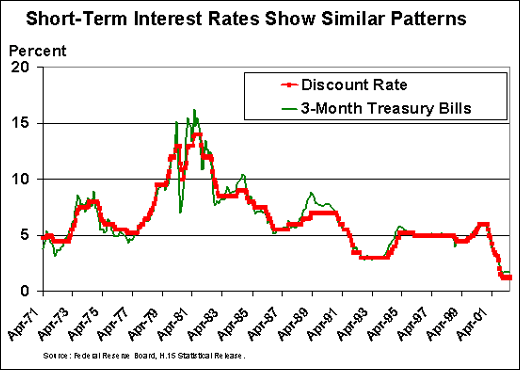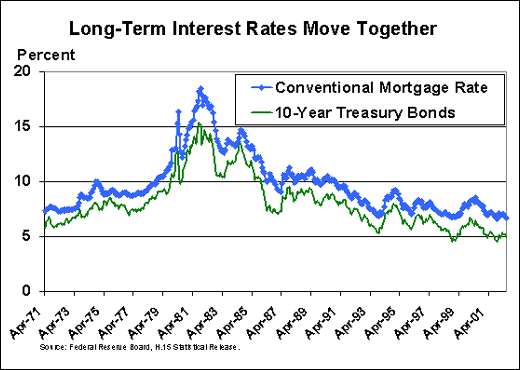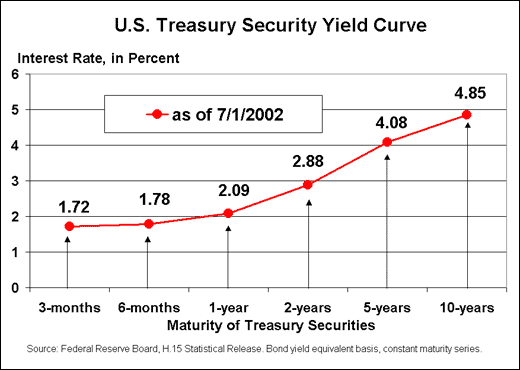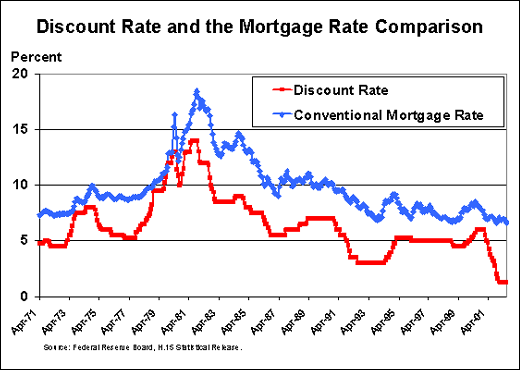What is the relationship between the discount rate and mortgage rates?
The Discount Rate is the interest rate the Federal Reserve Banks charge depository institutions on overnight loans. It is an administered rate, set by the Federal Reserve Banks, rather than a market rate of interest. The primary conventional mortgage rate is a market-determined interest rate for long-term residential mortgage loans. A change in the short-term discount rate may not affect interest rates on long-term mortgages.
Let me simplify the question: How do these two interest rates behave over time? As the evidence presented below indicates, while these two interest rates tend to move together, they also may follow different paths from time to time. For example, in 2001 stimulative Federal Reserve monetary policy reduced the discount rate to 1.25 percent, its lowest rate in more than 50 years. In contrast, mortgage rates fell only slightly during the same period.
The Discount Rate
The discount rate is the interest rate on secured overnight borrowing by depository institutions, usually for reserve adjustment purposes. The rate is set by the Boards of Directors of each Federal Reserve Bank. Discount rate changes also are subject to review by the Board of Governors of the Federal Reserve System. Movements in the discount rate and its use as a monetary policy tool are described in the Fed's Purposes and Functions:
The basic discount rate is adjusted from time to time, in light of changing market conditions, to complement open market operations and to support the general thrust of monetary policy. Changes in the discount rate are made judgmentally rather than automatically and may somewhat lag changes in market rates. The immediate response of market interest rates to a change in the discount rate -- the announcement effect -- depends partly on the extent to which the change has been anticipated. If rates have adjusted in anticipation of a change in the discount rate, the actual event may have only moderate effects on market conditions.
Over time, the discount rate tends to move fairly closely in line with other short-term interest rates. Chart 1 compares the movements in the discount rate and a short-term market-determined rate of interest, the three-month secondary market Treasury bill interest rate. Notice that the market-driven Treasury bill rate is more volatile (shows more up and down spikes) than the discount rate set by the Fed.
Chart 1

The Mortgage Rate
The residential mortgage rate is the market-determined "contract interest rate on commitments for fixed-rate mortgages" published by the Federal Home Loan Mortgage Corporation (FHLMC or Freddie MAC). It represents the long-term end of the interest rate spectrum. Lenders must incorporate into their long-term loan pricing decisions their expectations for future inflation and interest rates. Movements in the mortgage rate also reflect supply-and-demand conditions in the market for mortgage-backed securities. Over time, movements in the primary conventional mortgage rate are highly correlated with movements in other long-term interest rates, like the 10-year constant maturity Treasury bond rate. Both interest rates are shown in Chart 2.
Chart 2

The Yield Curve
A yield curve plots interest rates as of a particular date by their maturity -- by how many months or years in the future they will mature. A typical yield curve for Treasury securities might include the interest rates (converted to a bond yield equivalent basis) for a series of maturities, ranging from the short-term (three-month Treasury bills) to the long-term (ten-year Treasury bonds). Normally, the yield curve is upward sloping, as it was on July 1, 2002, shown in Chart 3. However, during some periods of tight monetary policy, short-term rates have risen above long-term rates, and the yield curve becomes downward sloping or inverted. In fact, during one of these periods in late 1979 the overnight discount rate actually was higher than the long-term mortgage rate.
Chart 3

Comparing Discount and Mortgage Rates
As the "typical" yield curve indicates, long-term interest rates tend to be higher than short-term rates. This relationship reflects inflation premiums and liquidity factors associated with long-term securities. However, short-term and long-term interest rates may diverge from this pattern, depending in part on factors like monetary policy and expected inflation prospects. During periods when the yield curve is inverted or downward sloping, short-term interest rates are higher than long-term rates. These shifts in the yield curve tend to reduce the correlation between movements in the overnight discount rate and the 30-year mortgage rate. Still, as is shown in Chart 4, over time the discount rate and the mortgage rate tend to experience similar trends, although the relationships between the two short-term interest rates shown in Chart 1 and the two long-term interest rates shown in Chart 2 are closer.
Of interest in early 2002 is the wide differential between the mortgage rate and the discount rate. A series of discount rate reductions for monetary policy purposes lowered the discount rate sharply in 2001. In contrast, the mortgage rate remained fairly stable during the period.
Chart 4

